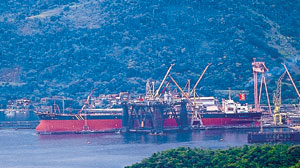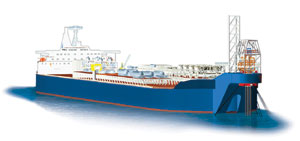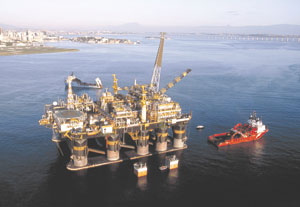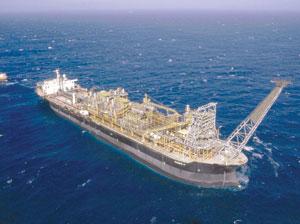Brazil's upstream sector remains resilient in down market
Regional ReportBrazil's upstream sector remains resilient in down marketSeveral new discoveries, technological advances and distinctive development projects are combining to help Brazil's E&P sector buck the stagnant global marketKurt S. Abraham, Managing/International Editor Even as global E&P activity struggles through a mediocre year, Brazil's upstream industry continues to rack up significant achievements. New oil production records continue to be set and broken with almost routine regularity. New discoveries of giant oil and gas fields (albeit mostly by Petrobrás) continue to tempt operators into venturing into deeper waters while committing expanded E&P budgets for developments in frontier areas. Greatest focus of exploratory activity remains the Campos basin, with work also taking place in the Santos basin to the south and Espírito Santo basin to the north. Yes, Brazil has its limitations, most notably what many consider an onerous fiscal regime, as well as a perplexingly low rate of commercial discoveries (a number of sub-commercial finds have been hit by foreign operators). Nevertheless, Brazil's offshore sector remains fertile for expanding technical knowledge. Governmental agency ANP is also working to further encourage activity by opening more acreage and obtaining faster approval times for environmental permits. Bidding & Concessions As of September 2002, there were 37 concessionaires with agreements in the exploration phase, Table 1. In addition, there were 17 companies with active agreements in either the development or production phase.
Compared to the three previous auctions, Brazil's 4th Licensing Round was somewhat of a disappointment. Held in mid-June, the round succeeded in selling only 21 of 54 blocks on offer. ANP acknowledged that demand and premiums paid were well below Round 3's level, due to what the agency called “a variety of local and international factors.” To no one's surprise, Petrobrás led the way, picking up eight tracts. Next active on the list was local firm Querioz Galvao, which took three blocks. Partex Oil & Gas won two concessions, while the remaining tracts auctioned were parceled out, one apiece, to BHP Billiton, Devon Energy, Dover Investments, Maersk Oil & Gas, Newfield Exploration, Petro Reconcavo, Shell and Starfish Oil & Gas. Highest bid received was Maersk's offer of 15.1 million reals (U.S. $4.03 million) for Santos basin Block BM-S-29. In total, the 4th Round garnered 92.32 million reals ($24.61 million). ANP announced in September that it will make exploration licensing rules more accommodating. Key element of the new, flexible scheme will be allowing oil companies to define the sizes of individual blocks to be awarded in the 5th Round. For the first four rounds, ANP had defined all block sizes. The new scheme has been used with success in numerous other oil-producing countries, and it is expected to lure more operators to Brazilian tracts, particularly medium-sized and local firms. As this article went to press, an announcement of which blocks will be offered in the 5th Round was due. A road show was also planned for this month. Several basins have already been chosen to contain the offered blocks, including Campos, Santos, Pelotas, Espírito Santo, Jequitinhonha, Reconcavo, Potiguar, Barreirinha and Foz do Amazonas. Since entering into partnerships with Petrobrás, seven foreign operators have notified ANP of discoveries. These firms include Amerada Hess, BP, Devon Energy, El Paso, Repsol-YPF, Shell and Unocal. However, not one of the discoveries up to mid-2002 has been considered profitable. These operators continue to evaluate the finds already made. Exploration Highlights Petrobrás said at the end of last May that it would restructure its exploration division, creating a Business and Exploration unit in Rio de Janeiro, responsible for all of Brazil's deepwater concessions / blocks. This latest move is a significant revision of Petrobrás' decentralization of management in 2000, which had been an attempt to create more decision-making flexibility, especially as relates to exploratory concessions. At that time, executives established nine new administrative units throughout the country, each gaining control of certain E&P concessions. These units were also handed responsibility for operational and productive installations. Of the nine units, Ceará, Espírito Santo, Campos (RJ) and Amazones will now be administered from Rio de Janeiro. However, the units in Rio Grande do Norte, Sergipe, Alagoas, Bahia and in the south of Brazil will remain autonomous outside of Rio. Major oil find struck. During August 2002, Petrobrás announced the discovery of a 600-million-bbl “giant” oil field in the Campos basin. The BC-60 find is 80 km offshore the southern coast of Espírito Santo state in waters 1,246 m deep. According to Petrobrás, a field is considered a giant if it contains 600 million bbl of oil reserves. This is the company's largest discovery since Roncador field was found in 1996. Roncador remains Brazil's largest oil field. Officials said that the 600-million-bbl estimate only reflects the reservoir's main section. Assuming this volume is confirmed, BC-60 will be the same size as East Albacora, one of Petrobrás' five largest fields. The new field contains very heavy oil that will be hard to extract, and further drilling is needed to appraise the field's limits. Nevertheless, officials said that the discovery well tested 3,000 bopd, and they believe that BC-60 could eventually produce 20,000 bopd. By comparison, about 30,000 bopd are produced from 49 wells at Roncador, where output slumped after the P-36 platform sank in March 2001. TFE gets lucky, too. Yet another dose of good news was announced on May 31, when French firm TotalFinaElf (TFE) told ANP that it had discovered oil in the Campos basin's BC-2 Block, operated in partnership with Shell and Petrobrás (TFE participates in three Brazilian concessions, in total). This find is in a different portion of the same block in which TFE struck an oil discovery during January 2001. The latest find is believed to contain a heavy crude, suggesting that extraction will be difficult, and market value will be diminished. TFE has been testing the discovery, and appraisals will be needed to determine if the reservoir is commercially viable. In August 2003, the concession's exploration phase is due to end. New Albacora reservoir detected. Meanwhile, in the giant Albacora field complex of the Campos basin, Petrobrás last summer found a new deposit of oil below the existing productive reservoir. This new find boosts Albacora's reserves by at least 150 million bbl of oil. Officials had originally estimated Albacora's reserves at 600 million bbl, but they believe that additional deposits may exist below the reservoirs already found and produced. If so, then technological advances should spur their development, as production costs will be less, given the infrastructure already in place. Development Projects Petrobrás President Francisco Gros said in August that total investments in Campos basin will total $17.6 billion by 2005. “Of that total, $8.3 billion will be used for 10 new production and/or drilling vessels for deepwater operations,” said Gros. Meanwhile, several different offshore development projects are underway, all featuring various floating production vessel schemes, Fig. 1.
Deepwater projects. ABS of Houston is providing classification services and consulting to five floating production projects – four operated by Petrobrás and one operated by Shell. The scope of classification includes:
A fully classed unit includes oversight of:
The five FPSOs include SBM's Brasil, P-43, P-48, P-50 and Fluminense. The latter will be operated by Shell. First unit slated for delivery in September was Brasil, with installation to begin immediately, followed by first oil in October (see additional comments in “Production” section). “One of the biggest class challenges with this project has been the short conversion timeframe of 16 months from project start in June 2001 to first oil in October 2002,” said ABS Brazil country manager João Carlos Pacheco. Next on Pacheco's list for installation will be the P-48 FPSO, slated for Caratinga deepwater field, Fig. 2. The 150,000-bopd vessel can store about 2 million bbl of oil and will be moored at a water depth of 1,040 m. It has been converted from the VLCC Stena Concordia and is designed to support 77 risers and umbilicals.
Following close behind P-48 is the P-43, converted from the VLCC Stena Continent (sister to Stena Concordia) and destined for Barracuda deepwater field. Also designed to produce 150,000 bopd and store 2 million bbl of oil, P-48 will be moored at a water depth of about 800 m. It is designed to support up to 107 risers and umbilicals. Another Petrobrás project will be development of Albacora Leste deepwater field. Designated vessel for this effort will be the P-50 FPSO conversion of the VLCC Felipe Comarão. Production of up to 180,000 bopd will begin in 2004. Unlike previous conversions, Petrobrás has awarded contracts for various production facility modules and accommodations to different suppliers (in part, to meet Brazilian content demands). The main contractor, Jurong Shipyard, will assemble the modules to complete the conversion. Particularly notable among all projects is Shell's development of Bijupira-Salema field in deepwater Block BC-10 of the Campos basin. Once this field goes onstream in mid-2003, Shell will become the first foreign firm to produce oil in Brazil since 1997, when exploration was opened to operators other than Petrobrás. Of $1 billion that Shell expects to invest in Brazilian E&P over the next four years, the vast majority will go toward Bijupira-Salema field. Average water depth of the field, 110 km (68mi) offshore Rio de Janeiro state, is 700 m. Plans call for a $250-million conversion of the VLCC Sahara, one of the world’s 15 largest tankers, to the Fluminense FPSO, Fig. 3. This vessel will store 1.3 million bbl of oil and process 70,000 bopd and 75 MMcfgd. MODEC International will own Fluminense, which is being converted in Singapore and is slated for field delivery in April or May 2003.
Other projects. Petrobrás is also investing $100 million to develop Peroa and Cangoa fields in the Rio Doce delta, 50 km offshore Espírito Santo state. Oswaldo Monte, Petrobrás' general manager for the state, said the two fields have combined reserves of 15 Bcm of predominantly natural gas, although some condensate becomes available during production. “Both the dry gas and condensate are of excellent quality,” said Monte. Plans call for beginning production next July, with output reaching 1.4 MMcmd and 1,000 bcpd. Production will be delivered to Vitoria, the capital of Espírito Santo. “We completed public hearings to secure environmental licensing, and there were no major surprises,” said Monte. As of August, five production wells had been drilled, with water depths averaging 60 to 67 m. Petrobrás engineers were also tendering contracts for construction of the PPER-1 platform, to be placed in Peroa field with a link to handle Cangoa output, too. Prior to these facilities coming online, Espírito Santo has 37 producing fields, of which 36 are in the north of the state, and one (Cacao) is offshore. An unexpected increase in Marlim Sul oil field's (Campos basin) production potential has prompted Petrobrás to lease an additional FPSO. Once installed, the FPSO will increase field capacity to 280,000 bopd from 180,000 bopd. Currently, some of Marlim Sul's existing wells are connected to the P-40 FPSO (Fig. 4), but they are slated to be transferred to the new unit.
Because the company expects to produce peak output from Marlim Sul for only seven to nine years, officials decided to subcontract the vessel rather than own it outright. Daily leasing cost for this FPSO will be about $250,000, and it should go onstream in second-half 2004. Given the high cost, Petrobrás intends to reconnect the diverted wells back to P-40 when field output declines sufficiently. Despite claims that domestic firms are capable of supplying such an FPSO, the operator expects to award the contract to a specialized foreign firms. One of the considerations will be the ability to supply crew services in addition to the vessel. At press time, Bluewater, SBM and MODEC were considered to be the front-runners for this award. Simultaneously, Petrobrás is offering a contract to convert a tanker to the P-47 FPSO. Several pre-selected firms will be invited to compete for the contract, all of them domestic companies. Production Brazil continues to maintain a steady path of progress in oil output. Last March, the country achieved an average production rate of 1.5 million bopd, up 1.7% from the previous month and up 12.3% from a February 2001 rate of 1.335 million bopd. Most of the production increase can be attributed to bringing Marlim field's P-35 and P-37 FPSOs to full output, Fig. 5. When natural gas output is added, the average volume produced by Petrobrás last March was 1.822 million boe. Gas output averaged 286,500 boe, compared to 286,100 boe in February.
Production increases have continued throughout this year. On May 12, Petrobrás for the first time produced 1.6 million bopd. Credit for the new record was given to the Campos basin offshore Rio de Janeiro state, which produced 1.322 million bopd of the total. In particular, Petrobrás noted the productivity of Marlim, Albacora and Marlim Sul deepwater fields, which produced 605, 488; 149,773 and 173,271 bopd, respectively, for a combined 928,532 bopd. For all of May, Brazilian oil production surpassed 1.5 million bpd for a third month in a row. May's performance was surpassed by June's output levels. Petrobrás broke its output record for a fourth month in a row, producing 1.583 bopd and 277,000 boed (44.35 MM cmd) of natural gas. Company officials attributed the increases to several new oil wells going onstream, as well as greater operating efficiencies at Campos basin platforms and production vessels. Finally, in August, the firm set yet another monthly record, producing 1.587 million bopd, as Petrobrás began celebrating 25 years of production from the Campos basin. At press time, Petrobrás was set to re-start output at the Roncador fields complex. The FPSO Brasil arrived in the Campos basin for temporary installation at Roncador. This will allow output from various pools in the complex, substituting for production capability lost last year when the P-36 vessel exploded and sank. Output will be restored to approximately 90,000 bopd and 5 MMcfgd until a new FPSO is installed permanently. Petrobrás has begun requesting bids from Brazilian and foreign oil service firms for construction of a new vessel that will have capacities similar to the P-36. Once constructed, the new vessel is planned to begin operating in 2004. Flaring issue. ANP and Petrobrás have been engaged in a bit of a flap over natural gas flaring. ANP earlier this year put together a study that accuses Petrobrás of needlessly flaring 8 MMcfgd offshore in the Campos basin. Calling the level “unacceptable,” the agency said that this volume equates to a deferred cost of $250 million/year if the gas were utilized commercially. These findings/accusations were denounced by Petrobrás E&P Director Jose Coutinho Barbosa. “The natural gas being flared in the Campos basin is approximately 4.8 MMcmd,” said Barbosa. “This average is 23% less than the average for 2001 (6.2 MMcmd), in spite of the current output of natural gas being 22% higher than (a year ago). In 2001, Petrobrás fully complied with the daily flare-off target of 6.24 MMcm set by ANP. The 2002 target is still being negotiated with ANP and will be less than the 2001 figure.” Improved flaring levels are partially credited to a Petrobrás investment program, whereby field compression was added and existing pipelines were expanded. Barbosa said that these investments are long-term and will need two years to complete. “Further reductions in natural gas volumes flared would be possible only if Petrobrás were to further reduce oil output,” said Barbosa. “This is a move that would negatively impact the goal of Brazilian self-sufficiency by 2005.” The Campos basin still contributes 80% of Brazil's crude oil output. |
|||||||||||||||||||||||||||||||||||||||||||||||||||||||||||||||||||||||||||||||||||||||||||||||||||||||||||||||||||||||||||||||||||
- Regional Report: Guyana-Suriname (July 2023)
- Regional Report: Brazil (February 2023)
- International Forecast: Some noticeable recovery is finally underway (September 2022)
- Guyana-Suriname Regional Report: The overly generous PSA may be history (July 2022)
- Characterizing seismic facies in a carbonate reservoir, using machine learning offshore Brazil (June 2022)
- 2022 Forecast: Activity outside North America will lead global recovery (February 2022)
- Applying ultra-deep LWD resistivity technology successfully in a SAGD operation (May 2019)
- Adoption of wireless intelligent completions advances (May 2019)
- Majors double down as takeaway crunch eases (April 2019)
- What’s new in well logging and formation evaluation (April 2019)
- Qualification of a 20,000-psi subsea BOP: A collaborative approach (February 2019)
- ConocoPhillips’ Greg Leveille sees rapid trajectory of technical advancement continuing (February 2019)







